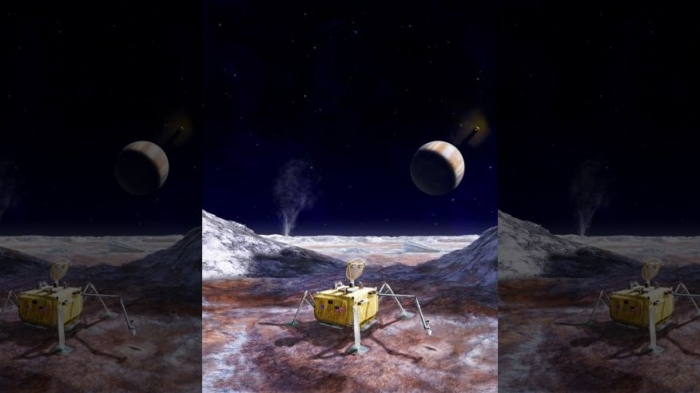“The submarine is not a part of any approved mission–yet,” Impey said. “There is a prototype design, but it is far from being folded into a funded mission. It would be the most direct and exciting way to search for life if it ever moves forward.”
One of Jupiter’s 67 moons, Europa has an ocean of liquid water hidden beneath its icy crust. This crust, which NASA estimates to be 10–15 miles thick, shields the water from Jupiter’s harsh radiation belts, which makes it one of the best candidates in the solar system for hosting life.
“We think it has all the ingredients that life requires – a large ocean of liquid water, the right chemical elements, and sufficient energy sources,” Dr. Cynthia Phillips, a Europa scientist working on the Lander concept at NASA’s Jet Propulsion Laboratory, said. “But just because life could exist on Europa doesn’t mean that life does exist there – that’s why we need to go there with a mission like a Europa lander to search for direct evidence of life.”
According to a 264–page report the space agency released earlier this year, a lander would launch around 2024 and use retrorockets and a sky crane to touch down on Europa’s surface at some point in 2031. It would then dig down at least ten centimeters below the surface to extract samples of the icy crust that have been shielded from radiation. The lander would then analyze the samples’ organic and inorganic contents using a powerful microscope capable of distinguishing microbial cells as small as 0.2. microns in diameter.
Researchers are also working on an autonomous submarine, developed as part of multi–million dollar grant from NASA, called ARTEMIS. The sub, which is nearly 14 feet long and weighs 2,800 pounds, would be used to explore the pitch–black waters underneath the Europan ice. Stone Aerospace, who developed and ran tests on the sub in Antarctica back in 2015, are also developing a nuclear–powered cryobot to laser through the 10–15 miles of icy crust. Currently, the bot’s maximum penetration rate is around 72 feet of ice per hour. While exciting, deploying the tech on Europa won’t happen for a long time.
Adds Phillips, “A mission that can melt or drill through Europa’s ice to access the ocean directly, perhaps with a submarine like ARTEMIS, is unfortunately a long way off.”However, just because the two space agencies aren’t joining forces doesn’t mean that the Europa lander mission isn’t going to happen. Despite the Trump administration cutting the mission from the budget, the NASA spokesman explained that the concept is still under consideration and could go forward at a future time.
Jupiter’s radiation puts the mission under the gun in terms of time. Housed within a radiation vault, the lander can only survive for about 20 days on Europa’s surface.
“The harsh radiation environment severely limits the lifetime of a mission to Europa’s surface, meaning that all the science has to be accomplished on a timeline of less than a month,” Phillips told Foxnews.com.
Contamination is also a big concern – the spacecraft itself must be sterilized to avoid contaminating the surface with terrestrial microbes. And, according to Phillips, these aren’t even the biggest challenges.
“Perhaps the biggest technical challenge is in developing instruments that will be able to detect signs of life,” she said. “Unfortunately, we don’t have a Star Trek–style tricorder that we can just point at the surface!”
The Trump administration’s 2018 federal budget blueprint might have cut the lander mission, but it did leave funding for continued development of NASA’s
Europa Clipper mission. Scheduled to launch sometime around 2022, the Clipper spacecraft will travel the five years it takes to get to Europa, then fly by the moon 40–45 times to take high resolution images of the moon’s icy surface. NASA researchers will then be able to get a better idea of Europa’s composition and structure.
“The challenges for the Europa Clipper are the long duration flight, getting enough power so far from the Sun (which is why a radioactive isotope must be used), and the intense radiation environment,” astrobiology expert Dr. Christopher Impey of the University of Arizona told Foxnews.com. “The radiation could make the spacecraft toast in a few months. So it will mostly be in Jupiter orbit, protected by Jupiter's magnetic field, and make occasional forays for a week at a time to do multiple passes of Europa and map it.”
Impey also points out that the Clipper instruments will only measure the potential habitability of the moon, not actually detect life. For that, we need the lander. But what would happen if NASA actually did discover life in the salty waters beneath the moon ice?
“If NASA does find life on Europa, this would be a huge scientific accomplishment, and potentially change our understanding of our place in the universe,” Cynthia Phillips said. “If life started not just once, but twice, in our very own solar system, then it becomes more probable that a large fraction of the exoplanets that we now know orbit other stars could also be inhabited. The answer could be earth-shaking!”
While acknowledging that the discovery would be dramatic, Impey had to bring the party down.
“The instruments can't look for DNA or RNA, only show that a metabolism is at work,” he said, “so it's not a slam dunk detection of Biology 2.0.”
/Fox News/
More about: #NASA
















































